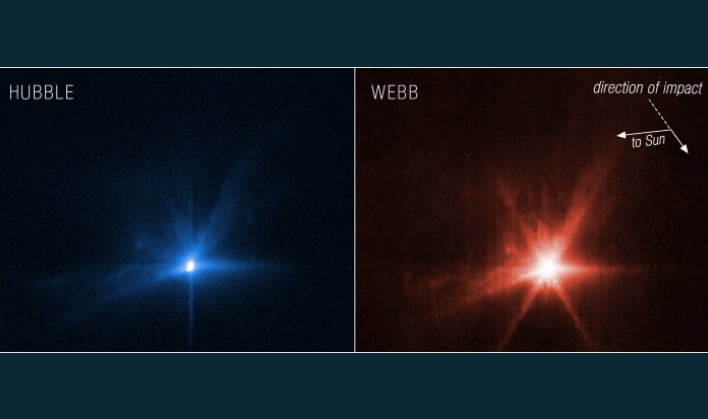Webb And Hubble Co-Capture DART Mission's 'Bigger Than Expected' Asteroid Impact
For the first time ever, NASA's Webb and Hubble space telescopes captured the same celestial target at the same time. The two observatories had front row seats as the space agency's Double Asteroid Redirection Test (DART) slammed into asteroid Dimorphos earlier this week.
Webb and Hubble images have been used in tandem in the recent past, as scientists and astronomers have used those images to compare data and unveil new findings. However, it was not until a NASA spacecraft slammed into asteroid moonlet Dimorphos, that the two actually recorded the same object in deep space at the same exact time.
NASA's DART mission completed its long journey on September 26, 2022, as it intentionally crashed into an asteroid in deep space. It was the world's first attempt at using a kinetic impact mitigation technique to try and change the speed and path of an asteroid. The hope is that the data collected through this mission can be used to avoid any future threats an asteroid or comet may present to Earth.
Webb's Near-Infrared Camera (NIRCam) was able to capture a "tight, compact core, with plumes of material appearing as wisps streaming away from the center where the impact took place." The speed of travel across the sky of the asteroid presented a unique challenge for Webb. The team prepared for the challenge in the weeks prior to the impact, in order to track asteroids moving over three times faster than the original speed set for Webb.
Hubble's Wide Field Camera 3 showed the impact in visible light, as seen above. The ejected material after impact can be seen as rays stretching out from the asteroid. The bolder, fanned-out spike of ejected material appearing to the left of the asteroid, is the general direction DART approached from.
Ian Carnelli, manager of the ESA's Hera mission, describes the impact as "a lot bigger than we expected." The Hera mission is similarly destined to visit the asteroid duo. It is scheduled to launch in 2024 and will reach the Dimorphos and Didymos to assess the damage in 2026. Simulations expected DART to create a roughly 10-meter (33-foot) crater, but after assessing the footage Carnelli wonders "if there is a crater at all, maybe a piece of Dimorphos was just chunked off."
While the opportunity to utilize both Webb and Hubble simultaneously is a milestone, NASA says, "there are also key science questions relating to the makeup and history of our solar system that researchers can explore when combining the capabilities of these observatories."
"Webb and Hubble show what we've always known to be true at NASA: We learn more when we work together," stated NASA Administrator Bill Nelson. "For the first time, Webb and Hubble have simultaneously captured imagery from the same target in the cosmos: an asteroid that was impacted by a spacecraft after a seven-million-mile journey. All of humanity eagerly awaits the discoveries to come from Webb, Hubble, and our ground-based telescopes - about the DART mission and beyond."
Webb and Hubble images have been used in tandem in the recent past, as scientists and astronomers have used those images to compare data and unveil new findings. However, it was not until a NASA spacecraft slammed into asteroid moonlet Dimorphos, that the two actually recorded the same object in deep space at the same exact time.
NASA's DART mission completed its long journey on September 26, 2022, as it intentionally crashed into an asteroid in deep space. It was the world's first attempt at using a kinetic impact mitigation technique to try and change the speed and path of an asteroid. The hope is that the data collected through this mission can be used to avoid any future threats an asteroid or comet may present to Earth.
Webb's Near-Infrared Camera (NIRCam) was able to capture a "tight, compact core, with plumes of material appearing as wisps streaming away from the center where the impact took place." The speed of travel across the sky of the asteroid presented a unique challenge for Webb. The team prepared for the challenge in the weeks prior to the impact, in order to track asteroids moving over three times faster than the original speed set for Webb.
Hubble's Wide Field Camera 3 showed the impact in visible light, as seen above. The ejected material after impact can be seen as rays stretching out from the asteroid. The bolder, fanned-out spike of ejected material appearing to the left of the asteroid, is the general direction DART approached from.
Ian Carnelli, manager of the ESA's Hera mission, describes the impact as "a lot bigger than we expected." The Hera mission is similarly destined to visit the asteroid duo. It is scheduled to launch in 2024 and will reach the Dimorphos and Didymos to assess the damage in 2026. Simulations expected DART to create a roughly 10-meter (33-foot) crater, but after assessing the footage Carnelli wonders "if there is a crater at all, maybe a piece of Dimorphos was just chunked off."
While the opportunity to utilize both Webb and Hubble simultaneously is a milestone, NASA says, "there are also key science questions relating to the makeup and history of our solar system that researchers can explore when combining the capabilities of these observatories."
"Webb and Hubble show what we've always known to be true at NASA: We learn more when we work together," stated NASA Administrator Bill Nelson. "For the first time, Webb and Hubble have simultaneously captured imagery from the same target in the cosmos: an asteroid that was impacted by a spacecraft after a seven-million-mile journey. All of humanity eagerly awaits the discoveries to come from Webb, Hubble, and our ground-based telescopes - about the DART mission and beyond."



